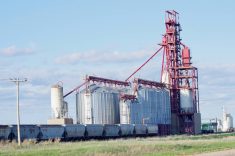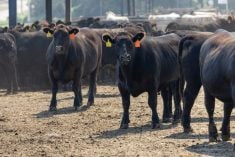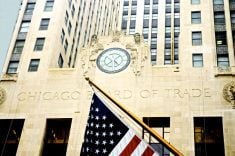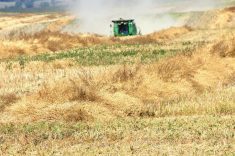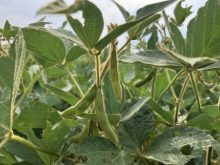By Theopolis Waters
CHICAGO, July 23 (Reuters) – Most Chicago Mercantile Exchange hog futures on Wednesday closed down the three-cents per pound maximum daily price limit in the wake of fund liquidation, traders said.
August ended 3.000 cents per lb. lower at 124.575 cents, and October at 110.450, 3.000 cents lower.
The price slide came as packers are reducing slaughter to match the number of available hos and grocers are reluctant to book large amounts of pork at near-record prices.
The average price of hogs Wednesday morning in the western Midwest, eased 79 cents per hundredweight (cwt) from Tuesday to $125.19, according to the U.S. Department of Agriculture.
Read Also

Near record September major grain deliveries: Statistics Canada
Canadian farmers made heavy deliveries of grains and oilseeds off the combine and into the commercial pipeline this September, with total deliveries of the major crops up 13.3 per cent from the same month the previous year, reported Statistics Canada.
Separate USDA data showed the morning’s price for pork at wholesale at $133.38 per cwt., down 46 cent from Tuesday.
FIRM LIVE CATTLE SETTLEMENT
CME live cattle futures settled higher after a volatile session, supported by expectations for higher cash prices this week, traders said.
CME live cattle brushed off a portion of the early-session’s profit-taking losses.
August live cattle finished up 0.100 cent per lb. to 156.050 cents, and October gained 0.125 cent to 158.000.
Packers short on supplies are expected to spend more for cattle while passing that cost on to grocers in the form of higher-priced beef, a trader said.
Cash cattle bids in Texas and Kansas developed at $156 per cwt. Last week, cash cattle in the southern Plains moved at mostly $155 per cwt, with sales of $156 to $157 in Nebraska.
Wednesday morning’s wholesale price for choice beef slipped 74 cents per cwt from Tuesday to $252.03. Select beef rose $1.54 to a record $247.33, the USDA said.
The government on Friday will issue the monthly Cattle-On-Feed report along with the twice-yearly cattle inventory survey that was reinstated after it was initially scrapped due to budget issues.
With respect to the on-feed report, most analysts believe fewer cattle entered feedlots last month than a year ago after lush grazing pastures allowed them to be nourished outside feedyards longer.
The inventory report has no comparative data for July of last year, making it difficult to determine the upcoming survey’s long-term implications, said University of Missouri economist Ron Plain.
He said CME cattle investors tend to focus on the monthly cattle reports because they wield more near-term industry and market influence.
CME feeder cattle contracts drew support from periodic live cattle market firmness and anticipation of fewer calves coming to market ahead.
August closed 1.225 cents per lb. higher at 217.250 cents and September up 1.625 cents to 218.400.


